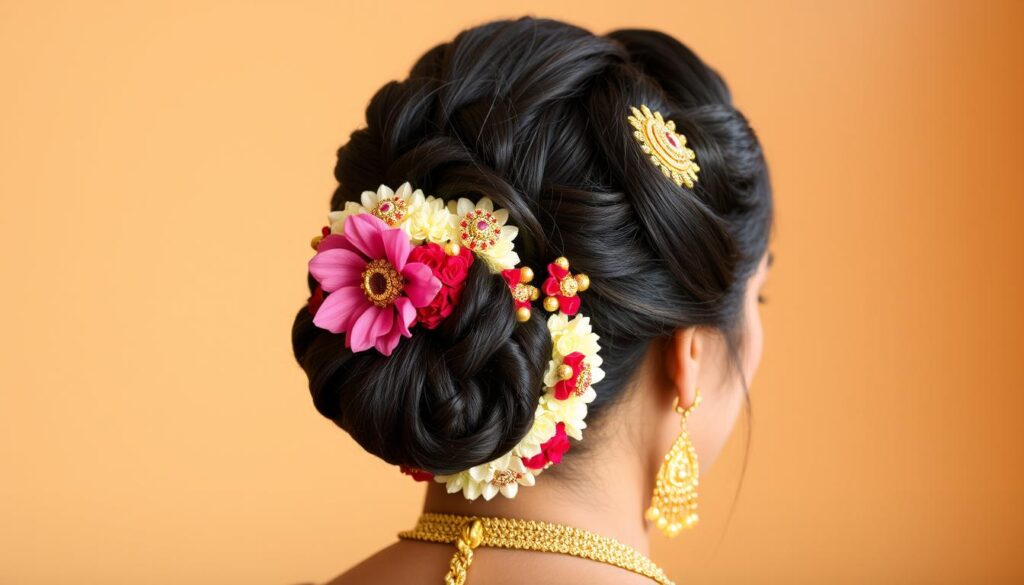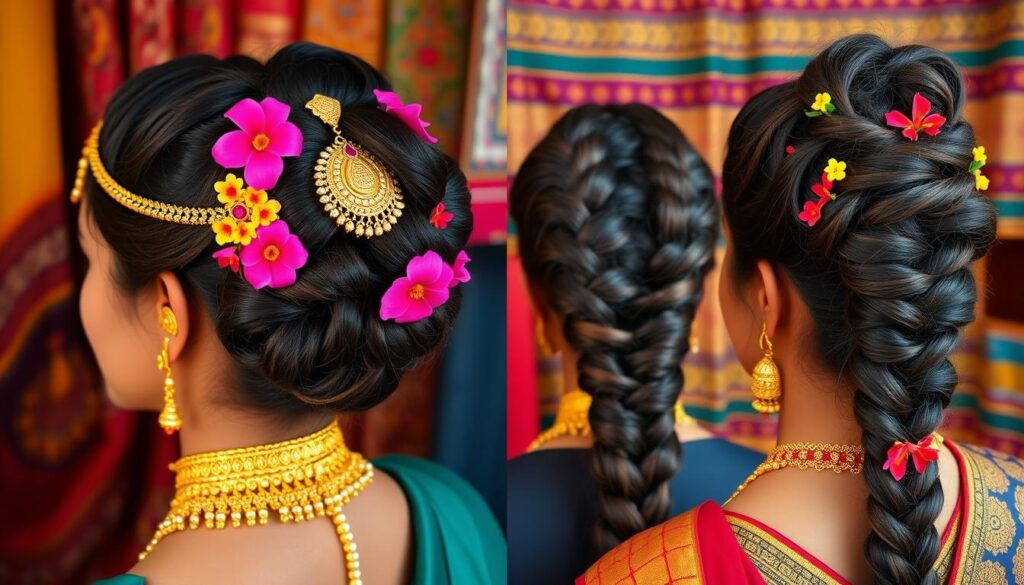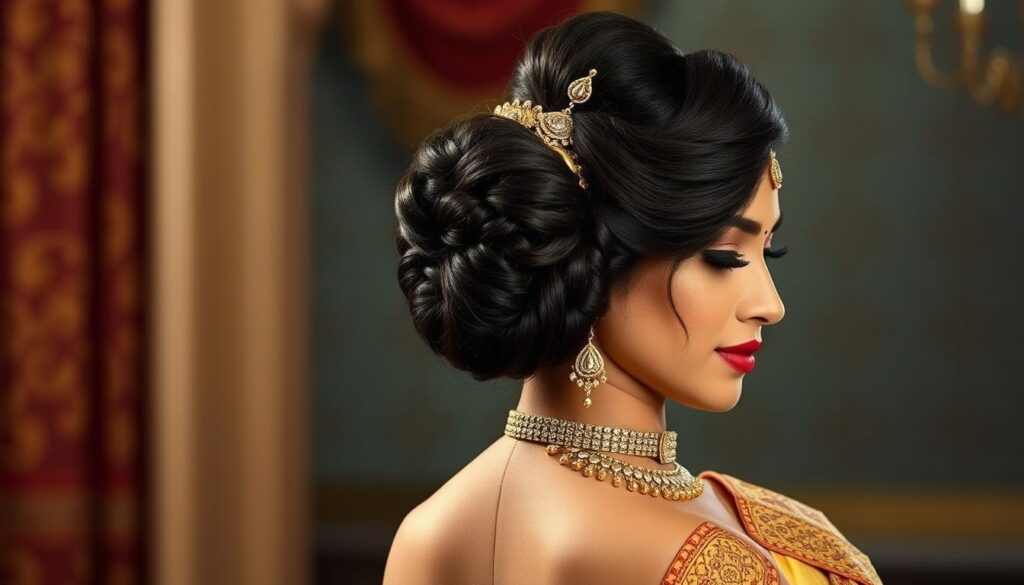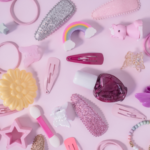Dive into the world of the classic Khopa, a hairstyle deeply rooted in Indian culture. This elegant updo has been a part of ancient traditions. It still charms people in India and around the world.
This article will take you on a journey to learn about the Khopa’s history and meaning. You’ll see how it’s styled and the tools needed. You’ll also learn how to make it perfect for any event, from festivals to formal gatherings.
Explore the many ways the Khopa has evolved across different regions. You’ll see how it has been updated with modern styles. This shows how the Khopa adapts to changing tastes while staying true to its roots.
Get ready to be amazed by the Khopa’s beauty and cultural importance. Join us as we uncover its secrets. Learn to embrace your heritage and show off your style with confidence.

Key Takeaways
- Discover the rich history and cultural significance of the classic Khopa hairstyle
- Learn the essential tools and techniques required to create the perfect Khopa for any occasion
- Explore the diverse regional variations and modern interpretations of the traditional Indian bun
- Understand the importance of proper hair care and maintenance for long-lasting Khopa styles
- Gain insights into the best occasions to showcase your Khopa and embrace your cultural heritage
Understanding The Classic Khopa (Bun) and Its Cultural Significance
The classic Khopa, or traditional Indian bun hairstyle, is more than just a hairstyle. It carries deep cultural meaning. This hairstyle is a part of the rich history and diverse cultures of India.
Origins in Ancient Indian Tradition
The Khopa’s roots go back to the Vedic era. It was seen as a sign of femininity, marriage, and spiritual commitment. Ancient texts show the Khopa as a symbol of a woman’s grace and respect for her culture.
Symbolic Meaning Across Different Regions
- In the northern regions of India, the Khopa shows a woman’s marriage and social standing.
- In the south, it’s decorated with ornaments and flowers, showing the area’s lively traditions.
- In the east, it’s a sign of religious dedication, especially to Hindu goddesses.
Cultural Importance in Modern Times
Even with new hairstyles, the Khopa is still loved in India. Women wear it to honor their heritage and keep Indian traditions alive.
“The Khopa is a testament to the enduring cultural significance of Indian hair traditions, serving as a bridge between the past and the present.”
Essential Tools and Accessories for Creating a Khopa
Making the classic Indian hairstyle, the Khopa, or bun, needs the right tools and accessories. You’ll need things to hold the hair and add fancy decorations. Each item is key to getting the perfect Khopa look. Let’s look at what you need to make a stunning Khopa that honors its cultural roots.
Hair Ties and Pins
The base of any Khopa is the hair ties and pins. Choose durable, flexible hair ties that won’t harm your hair. Hairpins, especially those with a traditional look, are great for keeping the bun in place.
Combs and Brushes
Smooth hair is a must for a polished Khopa. Get high-quality combs and brushes that detangle and style well. Look for ones with wide teeth or bristles to avoid hair breakage.
Decorative Accessories
The Khopa’s beauty comes from its decorations. Check out Indian hair ornaments, bun tools, hair accessories, and traditional pins. You can find metal clips, beads, flowers, or jeweled pieces to make your hairstyle stand out.
With the right hair accessories, bun tools, and Indian hair ornaments, you can fully enjoy the Khopa. It lets you show off the timeless beauty of this hairstyle.
“The Khopa is not just a hairstyle, but a canvas upon which we can paint the rich tapestry of our cultural heritage.”
Step-by-Step Guide to Creating a Basic Khopa Style
Learning the classic Khopa (bun) hairstyle is a cherished tradition in Indian culture. It’s perfect for embracing your heritage or trying a new stylish look. This guide will walk you through making a stunning Khopa. You’ll learn everything from preparing your hair to the final touches.
Preparation and Hair Sectioning
Start by making sure your hair is clean, dry, and free of buildup. Brush or comb your hair to detangle and smooth it. Then, divide your hair into three equal parts, starting from the crown. This ensures a balanced Khopa.
Wrapping and Securing Techniques
- Begin with the first section of hair. Wrap it around your fingers to form a small bun at the back of your neck.
- Secure the bun with bobby pins to keep it in place.
- Do the same with the other two sections, stacking each bun on top of the last.
- Adjust the buns to make sure they look seamless and unified.
Finishing Touches and Embellishments
To finish your Khopa, think about adding traditional touches like gajra (flower garlands), nath (nose rings), or jhumka (earrings). These can make your look more special and meaningful. Lastly, a light hold hairspray will keep your Khopa looking great all day.
“The Khopa is a timeless hairstyle that connects us to our rich Indian heritage. Embrace the beauty and versatility of this classic look.”
With this guide, you can confidently make a beautiful Khopa. It celebrates your cultural roots and adds tradition to any event. Explore different styles and modern twists to find your perfect Khopa.
Regional Variations of Traditional Khopa Styles
India’s rich cultural heritage has led to many regional hairstyles. The Gujarati Khopa and Bengali Khopa are just a few examples. Each style shows the unique traditions and beauty of its community.
The Gujarati Khopa stands out with its detailed and balanced design. It has a big, round bun with pins, flowers, or chains. On the other hand, the Bengali Khopa is simpler, with a sleek bun that highlights the neck and shoulders.
In the south, the Kondai style from Tamil Nadu and Kerala is unique. It has a tall, cone-shaped bun that might have a decorative comb or jada. This adds a touch of elegance to the look.
- Gujarati Khopa: Ornate, symmetrical design with decorative pins, flowers, or chains
- Bengali Khopa: Sleek, low-profile bun that accentuates the neck and shoulders
- Kondai: Towering, conical bun with a decorative comb or jada
These Indian regional hairstyles and cultural hair variations show the beauty of Indian culture. They also highlight the creativity and versatility of the traditional Khopa bun. Each style is a symbol of this timeless hairstyle’s lasting impact.

Modern Interpretations of the Classic Khopa Bun
The classic Khopa bun has seen a big change. Now, it mixes old traditions with new styles. This creates hair looks that people love all over the world.
Fusion Styles for Contemporary Occasions
Hairstylists have made the Khopa bun modern. They’ve made it sleek or fancy, perfect for big events. This shows how versatile the Khopa bun is, loved by many today.
Celebrity-Inspired Khopa Looks
Celebrities have made the Khopa bun famous. They’ve worn it to red-carpet events, mixing tradition with their own style. This has made many people want to try the Khopa bun.
Bridal Khopa Variations
The Khopa bun is special for Indian weddings. Now, brides wear fancy versions of it. These include flowers or jewels, making the wedding even more beautiful.
The Khopa bun keeps changing, showing how traditions can evolve. It’s seen on celebrities, at fashion shows, and at weddings. It’s a mix of old and new that everyone loves.
Maintaining and Preserving Your Khopa Throughout the Day
To keep your long-lasting bun looking great, you need to be dedicated and know the right hair maintenance tips. Here are some key steps to keep your secure hairstyle looking elegant all day:
- Choose the right products: Pick a strong-hold hairspray or gel to keep your Khopa in place. Stay away from heavy oils or serums that can make it look weighed down.
- Learn how to pin it right: Secure the bun with bobby pins, placing them in a criss-cross pattern for extra stability.
- Do quick fixes: Carry extra pins and a small hairspray for touch-ups. Gently fix any loose strands to keep your Khopa looking neat.
By using these easy hair maintenance tips, your Khopa bun will stay elegant and long-lasting all day. With a bit of practice, you’ll master keeping this classic hairstyle looking great.
Common Mistakes to Avoid When Styling a Khopa
Getting a perfect Khopa (traditional bun) takes practice and detail. Even pros can make common mistakes. Let’s look at the most common errors to avoid for this classic look.
Hair Preparation Errors
Good hair prep is essential for a great Khopa. Not brushing and detangling well can cause unevenness and messiness. Also, skipping a smoothing product can lead to flyaways and poor hold.
Securing and Pinning Issues
- Insufficient pinning: Not using enough pins can make the bun fall apart early.
- Improper pin placement: Wrong pin spots can mess up the Khopa’s look.
- Visible pins: Exposed pins can ruin the style’s finish.
Product Selection Mistakes
Wrong hair products can ruin your Khopa. Heavy pomade can weigh it down, and stiff gel can make it look unnatural. Not using a holding spray or powder can cause flyaways and poor hold.
| Common Hairstyling Errors | Solutions |
|---|---|
| Inadequate hair preparation | Thoroughly brush and detangle hair, apply smoothing products |
| Insufficient securing and pinning | Use enough pins and secure them properly within the hair |
| Unsuitable product choices | Select lightweight, non-greasy products and finish with a holding spray |
Avoiding these hairstyling errors can improve your bun troubleshooting skills. Find the right hair product tips for your hair type and style.
Best Occasions to Wear a Traditional Khopa
The Khopa, or bun hairstyle, is perfect for many formal Indian events. It’s great for weddings, religious ceremonies, and festive cultural gatherings. It makes you look elegant and connects you to your heritage.
The Khopa looks amazing with traditional Indian attire. It pairs well with sarees, lehengas, and other ethnic wear. This creates a beautiful and balanced look.
The Khopa is also a favorite for bridal hairstyles. It brings a sense of timelessness and grace. You can add flowers, juda pins, or other hair accessories to make it even more special.
| Occasion | Appropriateness of Khopa |
|---|---|
| Weddings | Highly Suitable |
| Religious Ceremonies | Highly Suitable |
| Festivals and Cultural Events | Highly Suitable |
| Formal Gatherings | Suitable |
Choosing the traditional Khopa hairstyle for these events is meaningful. It shows your cultural identity and makes your look more memorable.

Hair Care Tips for Perfect Khopa Styling
To get the perfect Indian hair care for your Khopa (bun) style, start with healthy hair. Follow these healthy hair tips and styling preparation steps. This way, your hair will be ready for flawless Khopa styling every time.
Nourish and Strengthen
Deep conditioning treatments are key for strong, soft hair. They’re perfect for Khopa styling. Use hair masks with coconut oil, argan oil, or Ayurvedic herbs to nourish and hydrate your hair.
Gentle Cleansing
Choose a sulfate-free, pH-balanced shampoo for gentle washing. Massage it into your scalp gently. Rinse well to avoid product buildup that can weigh down your Khopa style.
Smooth and Sleek
- Apply a leave-in conditioner or hair serum to control flyaways and keep your Khopa sleek.
- Finish with a light-hold hairspray to secure your style and keep it in shape all day.
Focus on your hair’s health and texture for the best Khopa hairstyles. This way, you can show off your cultural heritage with confidence.
Conclusion
The Khopa, or traditional bun hairstyle, is deeply meaningful in Indian culture. It has been around for ages, changing with each new generation. Women have made it their own, adding their special touch to this timeless look.
This hairstyle is more than just a trend; it’s a symbol of Indian heritage. It shows the beauty and strength of Indian culture. By keeping this tradition alive, we honor our past and help it grow in today’s world.
Wearing a Khopa connects you to India’s rich beauty heritage. It lets you join a long line of women who value their hair traditions. By keeping these practices alive, we make sure the Khopa’s story continues to inspire and evolve.
FAQ
What is the classic Khopa (bun) hairstyle?
The Khopa, also known as the traditional Indian bun, is a timeless hairstyle. It’s a structured bun that wraps and secures the hair. It’s often decorated with accessories and ornaments.
What is the cultural significance of the Khopa hairstyle?
The Khopa is deeply rooted in Indian culture. It symbolizes femininity, marital status, and cultural identity. It’s worn during important events, festivals, and ceremonies.
What tools and accessories are needed to create a Khopa?
You’ll need hair ties, pins, combs, and decorative items like flowers or beads. These tools help shape and secure the hair into a bun.
How do you style a basic Khopa hairstyle?
Start by preparing your hair, sectioning and smoothing it. Then, wrap the hair around itself and secure it with pins and ties. Add embellishments for a final touch.
Are there different regional variations of the Khopa hairstyle?
Yes, there are many regional Khopa styles in India. Each has its own unique look and cultural significance. Examples include the Gujarati, Bengali, and South Indian Kondai styles.
How can the classic Khopa be modernized?
Modernize the Khopa by blending traditional and modern elements. Use contemporary accessories and experiment with different bun shapes. Take inspiration from celebrity Khopa looks for a modern twist.
How can you maintain a Khopa hairstyle throughout the day?
Use the right products and proper pinning techniques to keep your Khopa looking great. Have quick touch-ups ready to ensure the bun stays neat and secure.
What are some common mistakes to avoid when styling a Khopa?
Avoid mistakes in hair preparation and improper pinning. Also, choose the right hair products. Fixing these issues will help you achieve a flawless Khopa.
When is the Khopa hairstyle most appropriate to wear?
Wear the Khopa at formal Indian events like festivals, weddings, and ceremonies. It complements traditional attire and adds elegance.
What hair care tips are important for achieving the perfect Khopa?
For a perfect Khopa, keep your hair healthy and strong. Follow good washing and conditioning routines. Use protective products and maintain a hair care routine for optimal styling.



